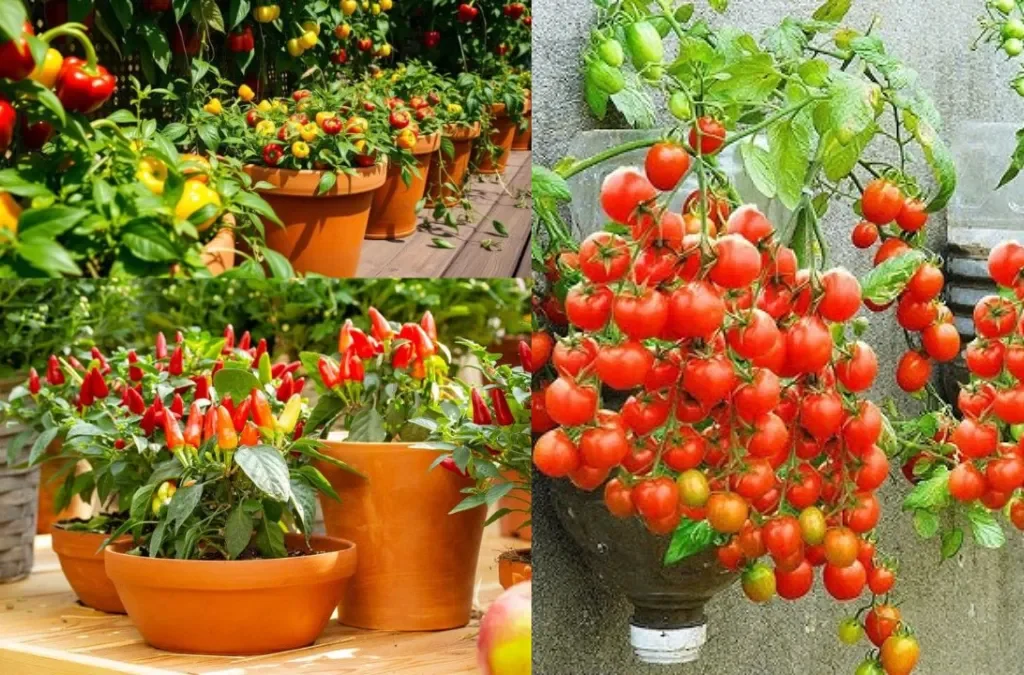Best Container Gardening Tips 2025- Container gardening has become increasingly popular in the United States, especially among urban dwellers with limited yard space. Whether you live in a bustling city apartment or a suburban home, growing tomatoes, peppers, and leafy greens in pots can provide fresh, healthy produce year-round.
With the right approach, even small patios, balconies, or sunlit windows can become thriving vegetable gardens. This guide will walk you through the best practices for container gardening in 2025, ensuring your plants flourish and yield delicious results.

Choosing the Right Containers
The first step in container gardening is selecting appropriate pots. Tomatoes and peppers generally need larger containers to accommodate their extensive root systems.
A container with at least 5 gallons of capacity is ideal for these vegetables. Leafy greens like lettuce, spinach, and kale can thrive in slightly smaller pots, around 2 to 3 gallons.
Make sure the containers have drainage holes to prevent waterlogging, which can harm plant roots and reduce yields. Terracotta, ceramic, and high-quality plastic pots all work well, though lighter containers are easier to move and reposition for optimal sunlight.
Selecting Quality Soil
Soil quality is crucial for container gardening success. Unlike garden beds, pots have limited space, which means nutrient-rich soil is essential. Use a high-quality potting mix rather than garden soil, as it provides better aeration and drainage.
You can enrich the soil with organic compost to supply essential nutrients naturally. For tomatoes and peppers, a slightly acidic soil with a pH around 6.0 to 6.8 works best, while leafy greens prefer slightly more neutral soil.
Regularly replenishing nutrients through organic fertilizers or compost teas will help maintain healthy plant growth throughout the season.
Choosing the Right Varieties
Selecting plant varieties suited for containers can make a significant difference. Compact or dwarf varieties of tomatoes, such as cherry or patio tomatoes, are excellent choices for pots.
Peppers also come in smaller cultivars like mini bell or hot peppers that thrive in limited space.
Leafy greens such as baby spinach, arugula, and butterhead lettuce grow quickly and produce multiple harvests, making them ideal for container gardens. Choosing the right varieties will ensure your plants remain manageable and productive.
Placement and Sunlight
Sunlight is essential for productive vegetable growth. Tomatoes and peppers require at least six to eight hours of direct sunlight each day, while most leafy greens can tolerate partial shade.
Position your pots in a sunny spot, such as a balcony, patio, or windowsill. If sunlight is limited, consider supplementing with LED grow lights designed for edible plants. Additionally, rotating pots periodically helps ensure even growth and prevents plants from leaning toward the sun.
Watering Techniques
Container plants require consistent watering because pots dry out faster than in-ground gardens. Water your vegetables deeply, allowing water to reach the entire root system.
Avoid frequent shallow watering, which encourages weak roots and stunted growth. During hot summer months, you may need to water daily, especially for larger pots containing tomatoes and peppers.
Mulching the soil surface can help retain moisture and reduce temperature fluctuations. Observing your plants closely for signs of wilting or yellowing leaves will help you adjust your watering schedule effectively.
Supporting Plant Growth
Tomatoes and peppers often require structural support to thrive in containers. Stakes, cages, or trellises help keep plants upright and prevent stems from breaking under the weight of fruit.
For leafy greens, thinning seedlings and gently pruning older leaves encourages new growth and maximizes the use of space. Regular maintenance, including removing dead or damaged leaves, helps prevent pests and diseases from spreading in your container garden.
Pest and Disease Management
Even in containers, vegetables can face challenges from pests and diseases. Common pests such as aphids, whiteflies, and spider mites can be managed through natural methods like neem oil sprays or introducing beneficial insects.
Keeping your containers clean and ensuring proper spacing between pots reduces the risk of fungal infections. Monitoring your plants daily allows for early detection and quick intervention, which is key to maintaining a healthy and productive garden.
Harvesting Your Vegetables
The joy of container gardening is harvesting fresh produce right from your own space. Pick tomatoes and peppers when they reach their mature color and size, as this ensures optimal flavor.
Leafy greens can be harvested continuously by cutting outer leaves while leaving the inner leaves to grow.
Frequent harvesting encourages new growth and extends your garden’s productivity. Enjoying homegrown vegetables not only provides nutritional benefits but also adds flavor and freshness that store-bought produce cannot match.
Frequently Asked Questions (FAQ)
Can I grow tomatoes and peppers together in the same pot?
It’s generally better to plant tomatoes and peppers separately. Both need ample space for roots and have slightly different nutrient requirements. Planting them together may limit growth and reduce yields.
How often should I fertilize my container vegetables?
A balanced liquid fertilizer every two to three weeks works well for container-grown tomatoes, peppers, and leafy greens. Organic compost or worm castings can also be added periodically to boost nutrient levels.
What is the best time to start container gardening in the USA?
Spring is ideal for most vegetables, especially after the last frost date in your area. Leafy greens can also be planted in early fall for a cooler-weather harvest.
Do I need to prune tomato plants in pots?
Yes, pruning helps maintain airflow, reduces disease risk, and directs energy to fruit production. Remove suckers that grow between the main stem and branches for better growth.
Can I reuse potting soil for the next season?
Yes, but it’s important to refresh the soil with new compost and nutrients. This prevents depletion and reduces the risk of soil-borne diseases.